by Daniel J. Leonard | Aug 11, 2017
Growing in containers can be one of the most versatile ways to add color, texture and mobility to the landscape. However, gardeners generally reach for finicky annuals to fill their pots with pizzazz. The problem with this strategy is that most annuals and perennials need to be watered constantly, fertilized regularly, and changed out with the seasons. That sounds like a little bang for a whole lot of buck! I and most of the real plant people I know fall squarely in the school of lazy gardening and believe there is an easier, less intensive, and ultimately less expensive way to get the same result. This can be accomplished by thinking outside the box and using an alternative class of plants that can fit the same bill of providing color and texture in pots without the headaches and have been sitting on the shelves right in front of us the whole time, the shrubs.
It is beyond me why shrubs aren’t used as container plants more often. Maybe the reason for the lack of use is pure perception; after all, no one with any sense would plant a giant, coarse green meatball or an enormous antebellum azalea in a decorative pot on their front walk. Recent innovations by plant breeders have left this argument moot though as new introductions of old species have revived interest in the entire group. Many of the best of these new cultivars sport traits perfect for container culture (dwarf growth habit, increased flowering, and interesting texture and form) while preserving the ironclad, undemanding nature of their parent plants. The following are a few of my favorite new shrub introductions for container growing!
- ‘Purple Pixie’ Loropetalum
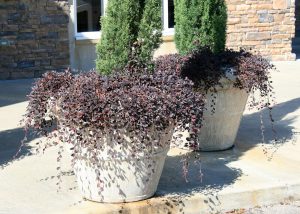
Purple Pixie loropetalum is a low-growing shrub that can spill beautifully out of a container. (Photo by MSU Extension Service/Gary Bachman)
If interesting architecture is what you require in a plant, ‘Purple Pixie’ must be on display in your yard. This dwarf cultivar of the wildly overused purple shrub Loropetalum chinense has taken the horticultural world by storm. The unique combination of true purplish foliage that only greens slightly in the hottest summer sun, ribbon-like pink spring flowers, and a graceful weeping habit make ‘Purple Pixie’ a winner. Give this plant a medium sized container (at least 12” in diameter), water when the soil begins to dry, fertilize infrequently with a slow-release formulation, site in full sun to partial shade, and enjoy for many seasons to come.
This is definitely not your granddaddy’s Ligustrum. Gone are the rampant growth, sickly sweet smelling flowers, and the aggressive nature of ‘Sunshine’s’ parent Chinese Privet (Ligustrum sinense). ‘Sunshine’ is a sterile cultivar with dwarf characteristics (growing 4-5’ with infrequent light pruning), vivid yellow-chartreuse foliage, and most importantly, no flowers. All ‘Sunshine’ asks of us is plenty of sun, occasional fertilizer and a light haircut once or twice a season! Use this plant to frame a dark flowerbed or in a container as a companion to the previous plant, ‘Purple Pixie’ Loropetalum for an extremely striking combination!
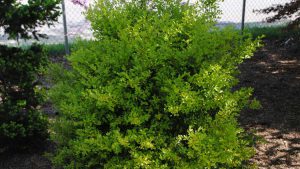
‘Sunshine’ Ligustrum. Photo courtesy of JC Raulston Arboretum.
A new take on a landscape standard, ‘Baby Gem’ is an exceptionally compact and slow growing cultivar of Buxus microphylla var japonica. All the same features gardeners love about traditional “full-size” boxwoods remains (tight, formal growth habit, ability to prune into many different shapes and ironclad constitution) but with ‘Baby Gem’ are delivered in a perfect package for a pot. This little “gem” of a plant is perfect for use in a smallish container to frame a formal landscape or to give a sense of order to an informal container garden or border!
So if you’re ready to stop replacing all of your potted plants each and every season, reach for one of these shrubs the next time you are at a garden center. You’ll likely be rewarded with compliments on your creativity, four season interest from the plants themselves, and more time to enjoy being in your garden instead of laboring in it! As always, if you have any questions about this or any other horticultural topics please contact your local UF/IFAS Extension office! Happy Gardening!
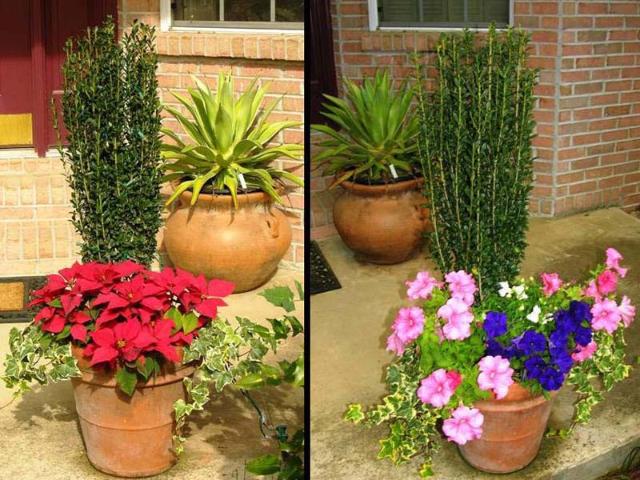
by Larry Williams | Aug 2, 2016
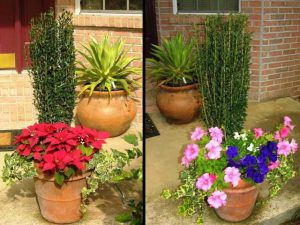
Containers to brighten bare spots. Photo Credit: UF/IFAS Extension
There are areas in most landscapes where it is not practical or possible to bring in the tiller and create a flowerbed. But that doesn’t mean you can’t have color in those areas. A little imagination, a decorative container and appropriate plants can turn a bare spot into a splash of color.
Consider using a container of annuals to add color to a backyard deck or a paved entrance way. Or what about that area under the tree where grass doesn’t want to grow and where it would be difficult to till without damaging the tree’s roots and the tiller? How about the dry spot where there is no irrigation but where it would be more practical to occasionally hand water a well-placed container of colorful caladiums?
A wide variety of flowering annuals work well in containers. But be sure to select plants based on the exposure. Some annuals quickly bake from full sun exposure and others become leggy and bloom poorly in a shady location.
Impatiens and begonias do well in shaded places and remain in flower almost continuously. Caladiums also do well in containers in shady areas. They don’t bloom but they have colorful leaves.
It’s more difficult to grow container plants in full sun but there are some annuals to consider for sunny spots. Periwinkle and all types of portulaca are heat tolerant and do well in full sun.
There are many other annuals that can be successfully grown in containers. You might like to try ageratum or salvia. In addition to annual salvia, there are numerous perennial types to try. And there are sun-tolerant begonia and sun coleus varieties for full-sun places.
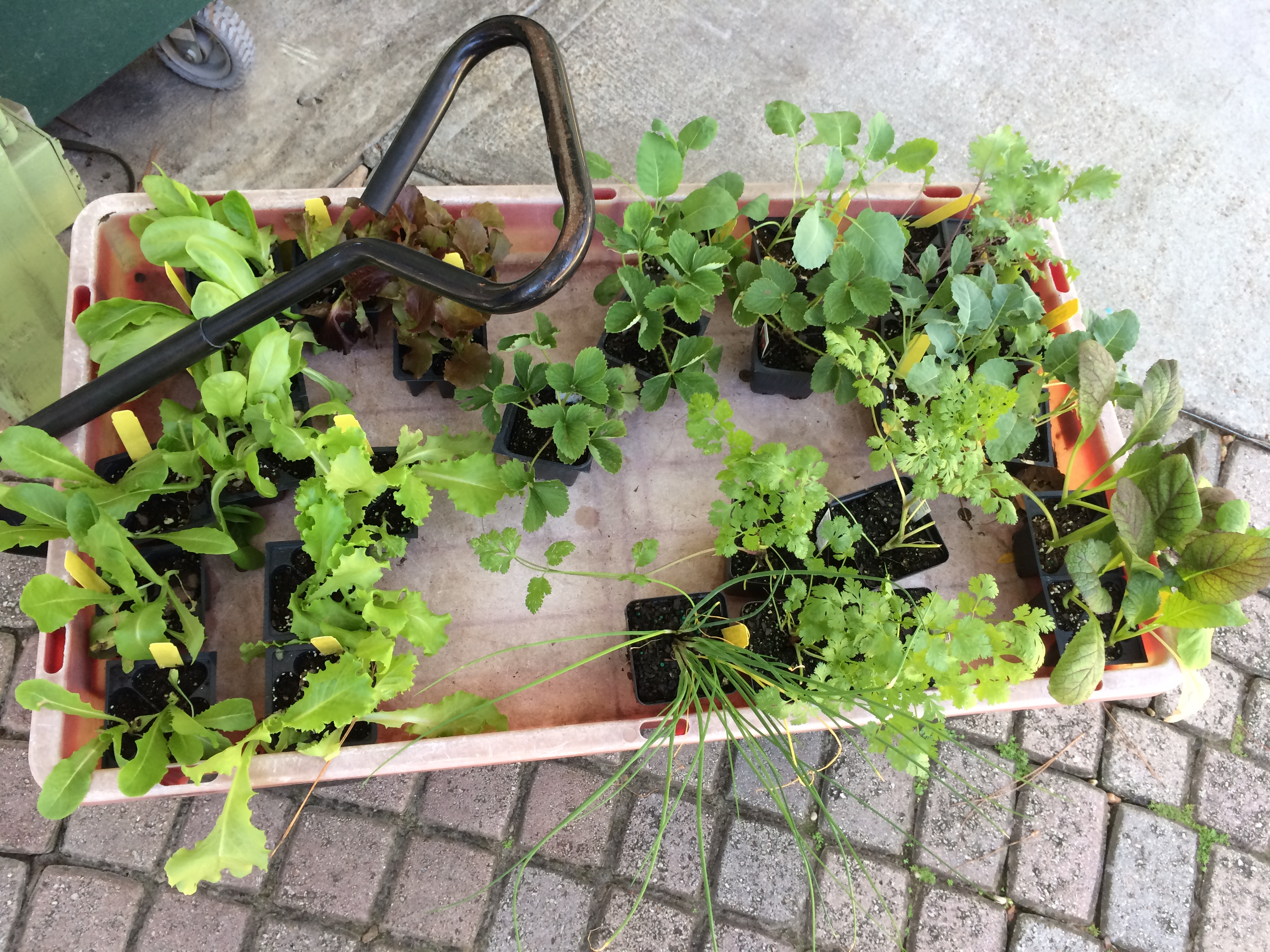
by Molly Jameson | Apr 27, 2016
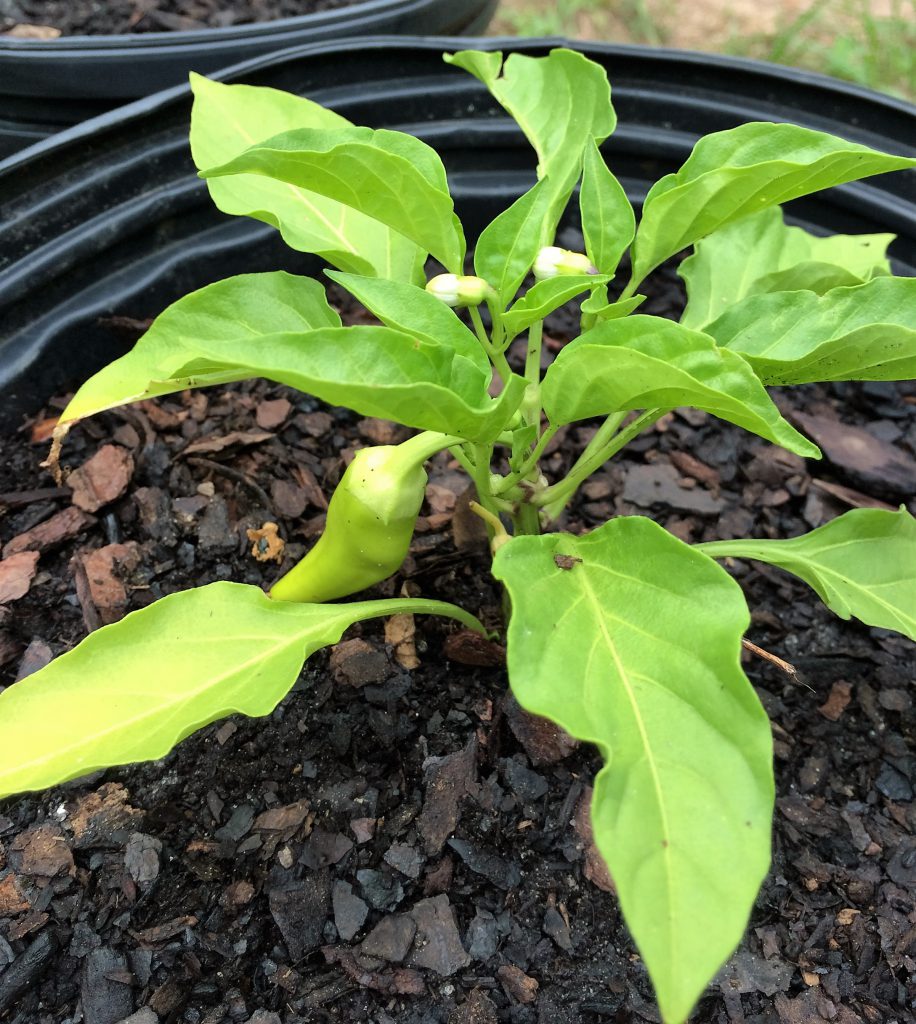
Banana pepper in container. Photo by Molly Jameson.
Interested in having a garden, but have limited space? Maybe you live in an apartment, have poor soil quality, or you just don’t have many areas that get enough sunlight. Maybe you’ve tried gardening, but given up, labeling yourself as one of those who “just doesn’t have a green thumb.” Well, I’m here to tell you, don’t give up! Try container gardening. Growing your own vegetables in containers is easy and can be a very rewarding experience. Container gardens also tend to have fewer weed, pest, and disease problems then regular in-ground gardens. Following just a few guidelines, you can have a bountiful harvest of fresh fruits, vegetables, and herbs right by your front (or back) door-step!
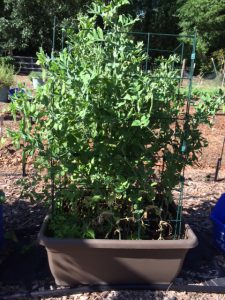
Grow vegetables easily in a large planter. Photo by Molly Jameson.
So, what are these guidelines, you ask? Well, you first want to choose the right container. This could be a large flowerpot, window box, planter, 5-gallon bucket, half-barrel, recycled material…the list can be endless. Just as long as your container is big enough and has proper drainage. Generally, the container should be at least 10 inches wide and 10 inches deep. The bigger the better, as it will give the roots more space to grow, and the soil will not dry out as fast. Tomatoes, for instance, do best in larger pots, preferably the size of a five-gallon bucket. For many herbs, you can get away with planting two or three different types in the same container. It is also important that your container has drainage holes, so water can escape and air can circulate. Use a one-fourth inch drill bit to create holes in the bottom or along the sides near the bottom of the container if it does not have holes.
Most of us know plants need both sunlight and soil. But just how much sunlight and what type of soil? If you are growing vegetables, it is best to have full sun – which means at least six hours of direct sunlight per day. An advantage of growing in containers is that you can easily place a container in an area of your yard or on a balcony that receives adequate sunlight, when it would be much more difficult to build a garden in these same areas.
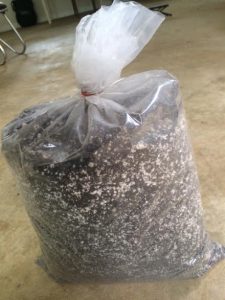
Buy potting soil in bulk to cut down on costs. Photo by Molly Jameson.
So what about soil? When growing in containers, you want to make sure you get potting soil that is made for containers. These mixes will contain materials such as peat, perlite, and vermiculite for both good drainage and moisture-holding capacity, and materials such as compost and nutrient amendments that will keep your plants healthy. You can simply ask your nursery specialist for a mix formulated to grow vegetables in large outdoor containers. If you are growing a lot of vegetables, you can cut down on costs by making your own mix. Just make sure you have a good balance of the aforementioned materials, and mix in a slow-release vegetable fertilizer, following directions on the label.
Now that you have your container, your soil, and a sunny location, it is time to get the plants. Some plants are best bought as transplants or grown from seed started indoors. Vegetables such as broccoli, collards, kale, tomatoes, eggplant, peppers, and strawberries fall into this category. Other plants, such as root crops, arugula, lettuce, spinach, mustards, beans, peas, cucumbers, squash, okra, cilantro, and basil can be started from seed directly into containers.
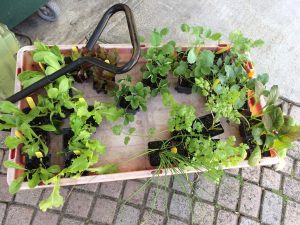
For some vegetables, buy transplants from your local nursery. Photo by Molly Jameson.
Okay, so you have all the materials. Now what? If you are growing from transplants, first thoroughly moisten the potting mix and the plant’s soil. “Transplant shock” is reduced when there is proper moisture. Set plants at about the same level they were growing in their original pot. For tomatoes, remove lower leaves and plant deeper in the container. If you are growing from seed, simply plant the seeds according to their label. A good rule of thumb is to plant the seed to a depth of about two to three times the seed’s diameter. If you are worried about your seeds not germinating, go ahead and plant more seeds than you need. But remember to thin to appropriate spacing if they do, indeed, all come up. Spacing will be specific to the type of vegetable.
After planting, water gently but thoroughly. Monitor your container garden, making sure the potting mix does not dry out. You can reduce evaporation by mulching with leaf litter, straw, or a similar material. Plants that grow tall or produce vines, such as tomatoes and cucumbers, will need support. A wire cage or pole, inserted into the container at planting time, will support the plant as it grows.
Last step is to call over all your friends and family and show off your beautiful vegetable plants! They will surely be impressed by your “green thumb” and will be eager to learn your gardening secrets.
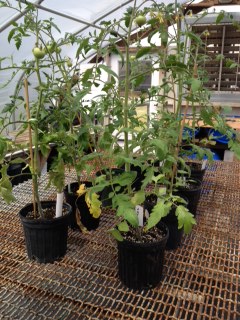
by Eddie Powell | Apr 14, 2015
Growing wholesome, healthy vegetables in a container are a way of life these days. Here are some easy and less expensive tips for creating that bucket garden.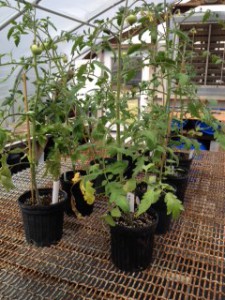
- In a large container or on a plastic mat on the ground, mix garden soil and compost in a 2:1 ratio. Two scoops of soil and one of compost, add the recommended quantity of slow release fertilizer from product label
- Drill 6 to 8- ½ inch holes in the bottom of the 5-gallon buckets. Make sure that the buckets did not contain toxic materials!
- Line the bottom of the bucket with gravel. You may substitute broken pottery or sticks that are broken in short links
- Fill the bucket to within 3 inches of the top of the container
- Place container in sunny spot that will allow drainage
- Plant chosen vegetable with two seeds in center of the container
- Water well and keep moist but not wet
- Place plant support around seeds
Plant requirements:
- Nutrients. Basic needs in plants are Nitrogen (N), Phosphorus (P), Potassium (K). These are listed on all fertilizers as a ratio, example – 8-8-8 contains 8% Nitrogen, 8% Phosphorus, and 8% Potassium and the remaining 76% is a filler. Soils contain many more trace minerals and they are listed on the fertilizer label including directions for use and amounts
- Sunshine or artificial sources of light (grow lights).
- Water. Soil must be kept moist but not wet. Wet soils will create root-rot and encourage fungus. Measure moisture by pinching the soil to see that the soil is moist but never wet. Adding water as needed; plants in hot areas will need much more water than plants in cool spots. Wilted plants need more water!
- Carbon Dioxide (CO2). Plants absorb CO2 and give off Oxygen making them VERY important to human and all animal life.
- Proper Temperatures. Plants will die when it is either too hot or too cold. Make sure that if your plants are outside and the temperature goes below freezing, the plants must be protected or brought inside.
Resources:
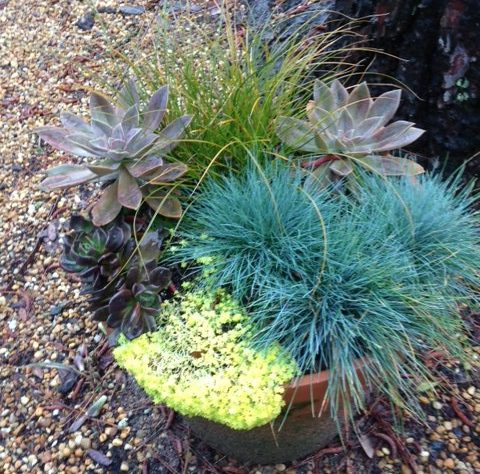
by Julie McConnell | Apr 1, 2014
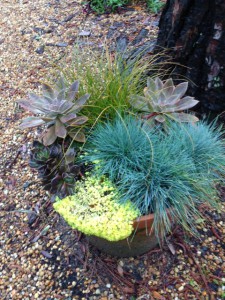
Container garden. Image: Julie McConnell, UF/IFAS
Living in a condo, apartment, or home with small yard does not mean you can’t garden at home. Whether you are interested in edible plants or ornamentals you can create a fit that is right for your space by using containers.
The first step in container gardening is the same as for traditional landscaping. First, asses your site to determine the cultural situation. Is it sunny or shady? Is water available from rainfall or from a nearby spigot? Will salt or wind be a factor? Are there height and width limitations? All of these need to be taken into consideration when you are planning to plant. These are elements that we have very little control over, so it is best to choose the right plants for the place you have.
Choose a container that will allow for adequate root growth and good drainage. If growing annuals, perennials, or small vegetables, a pot that is 12-18” deep should be sufficient. For shallow rooted or plants that like dry conditions you can go smaller. If plants grow tall make sure that the weight of the soil and pot is enough to keep it upright in gusty winds. It is not necessary to buy a container, you can reuse something as long as the water will drain and it is sturdy. Large containers may not need to be filled completely, but can be filled with a lightweight filler such as upside down nursery pots, water or soda bottles with lids, or packing peanuts. Choosing a light weight filler material makes the container easier to turn or relocate if needed and reduces the cost of potting soil.
Once you have determined site conditions, select the type of plants you would like to grow. When choosing edibles, the amount of sunlight available may be a limiting factor. Although some herbs and vegetables may benefit from a little bit of shade, they still need a bright location in order to produce well. If your site is very shady, consider shade loving ornamentals such as fern, hosta, and impatiens.
Understand the sunlight, water, and fertilizer needs of each plant. Group plants together that have similar requirements because they will receive the same care. Most herbs like a hot, dry situation and very little to no fertilizer. Grouping one of these herbs with a tomato plant that needs consistent watering and regular fertilizer will create a situation where one plant will perform poorly.
Container gardens require more care than plants in the ground because they dry out faster and may get no water from rainfall, if placed in a covered area. Consider using micro irrigation designed for containers or choose plants with low water needs such as the grasses and succulents.
To read more about container gardening read Container Gardening for Outdoor Spaces ENH1095.
The Foundation of the Gator Nation
An Equal Opportunity Institution













